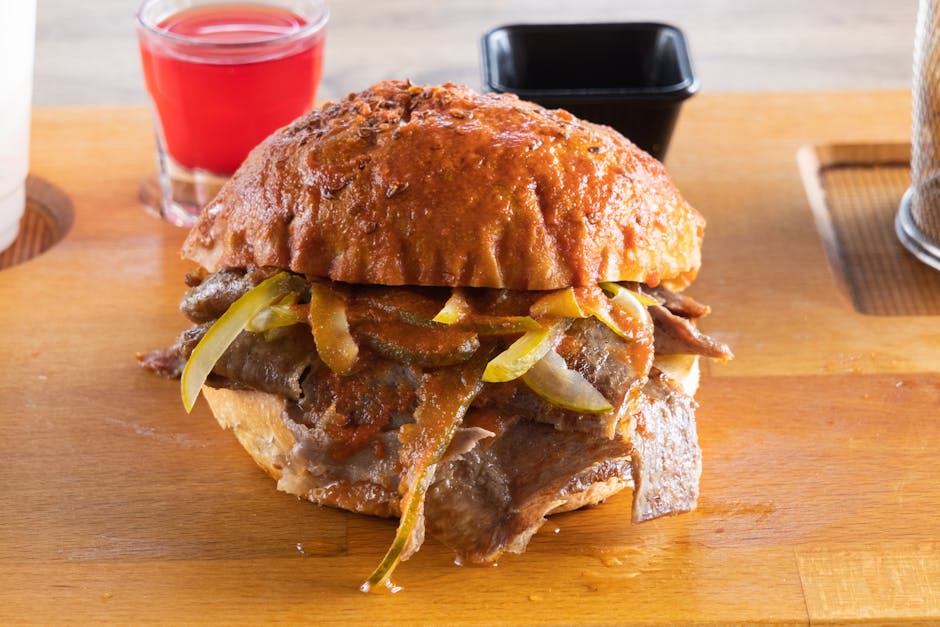Finding the World of Torta: Mexico’s Iconic Sandwich
A torta is a Mexican sandwich made with a soft, crusty roll (typically telera or bolillo) filled with layers of meat, beans, avocado, and various toppings. While “torta” means different things across cultures, the Mexican version has gained international fame for its hearty, flavor-packed profile.
What is a torta?
- Definition: A Mexican sandwich on a white roll with multiple layers of fillings
- Bread types: Telera (oval with two indentations) or bolillo (football-shaped)
- Common fillings: Carnitas, milanesa, eggs, beans, avocado, lettuce, tomato
- Regional variants: Torta ahogada (drowned in sauce), guajolota (with tamale filling)
- Origin: Developed in the 1860s, influenced by French bread-making during occupation
When I first encountered a proper Mexican torta on the streets of Mexico City, I was struck by how something seemingly simple—a sandwich—could become such a complex symphony of flavors and textures. Unlike the thin, restrained sandwiches of Europe or America, the torta accepts the “more is more” philosophy that makes Mexican street food so irresistible.
The word “torta” has a fascinating linguistic journey. In most Spanish-speaking countries, it refers to a cake, while in Spain it might mean a flatbread. In the Philippines, it’s an omelet. But in Mexico, this humble term transformed into something extraordinary—a handheld feast that reflects centuries of culinary evolution.
What makes the Mexican torta special isn’t just its ingredients but its cultural significance. As one Mexican saying notes, “A falta de pan, tortas”—”Where there is no bread, tortas will do.” This phrase, ironically, shows how the torta evolved from necessity into a beloved culinary icon found at dedicated torterías, street carts, and family celebrations throughout Mexico.
Whether you’re seeking breakfast comfort in a torta de huevo con chorizo (egg with spicy sausage), a hearty lunch with a torta de carnitas (slow-cooked pork), or the famous “drowned” torta ahogada of Guadalajara, this Mexican sandwich delivers satisfaction that far exceeds its simple components.

From Latin “Torta Panis” to Modern Street Icon
Ever wonder how a humble sandwich became a Mexican food icon? The story of the torta begins with its name, which traces back to Late Latin “torta panis” – literally meaning “twisted bread.” This ancient linguistic root gives us a glimpse into the long history of bread-based foods that would eventually evolve into the beloved sandwich we know today.
The torta as we recognize it emerged during a fascinating cultural collision. When French forces occupied Mexico in the 1860s, they brought more than just soldiers – they brought baking techniques. Clever bakers in Puebla began adapting French baguette methods, creating the telera and bolillo rolls that would become the backbone of the modern torta. This beautiful fusion represents the cultural synthesis that makes Mexican cuisine so special.
One charming origin story claims the first torta was created in 1892 by an enterprising eleven-year-old named Armando Martínez Centurión, who later opened Mexico City’s first tortería on Callejón del Espíritu Santo. Whether completely true or partially embellished, this tale captures the humble, inventive spirit behind this now-iconic food.
What Makes a Mexican Torta Unique
The Mexican torta stands apart from other global sandwiches through its perfect marriage of soft-yet-sturdy bread and generous, multi-layered fillings. While many European sandwiches accept minimalism, the torta celebrates abundance.
Food experts often describe the torta as a “baroque creation” – sometimes incorporating up to 25 different elements carefully stacked between bread halves. This delightful complexity reflects the Mexican approach to food that celebrates rich flavors and contrasting textures in every bite.
Beyond its flavor profile, the torta is brilliantly practical as street food. The specific qualities of telera and bolillo rolls – with their slightly chewy exterior and soft, absorbent interior – make them perfect for containing juicy fillings without turning soggy. This structural integrity allows tortas to be wrapped in paper or foil and eaten on the move, making them the ideal meal for busy urban dwellers, workers, and students.
It’s worth noting how different the Mexican torta is from other foods sharing the same name around the world – from the cake-like tortas of South America to the omelet tortas of the Philippines or Spain’s flatbread versions. The Mexican sandwich has carved out its own distinct identity and cultural significance.
Timeline of the Torta’s Rise
The journey of the torta from French-influenced bread to Mexican street food superstar spans over 150 years:
In the 1860s, French intervention brought European baking techniques to Mexico, inspiring local bakers to develop the telera and bolillo rolls that would become the foundation of the torta.
By 1892, young Armando Martínez Centurión had reportedly created the first torta and later established Mexico City’s first dedicated tortería.
The early 1900s saw the birth of regional variations, including the famous torta ahogada or “drowned sandwich” of Guadalajara – allegedly invented when a vendor accidentally dropped a pork sandwich into chile sauce. Happy accidents make culinary history!
Throughout the mid-20th century, tortas became firmly embedded in urban Mexican life, with specialized torterías appearing in cities across the country.
The late 20th century witnessed an explosion of regional variations, from Mexico City’s massive torta cubana to Puebla’s sesame-topped cemitas.
In the 21st century, the Mexican torta gained international recognition, appearing on menus throughout the United States and around the world as Mexican cuisine continued its global journey.
Today, the torta stands as a delicious testament to Mexico’s culinary creativity – changing borrowed techniques into something uniquely Mexican and universally loved. It’s the perfect example of how food evolves across cultures, picking up influences while maintaining its authentic character.
More info about World Cuisine Exploration
Anatomy of the Perfect Torta Sandwich

I’ve eaten more tortas than I care to admit, and I’ve come to realize that this beloved Mexican sandwich isn’t just thrown together—it’s a carefully crafted masterpiece with each component playing a crucial role. Let’s break down what makes the perfect torta so irresistible.
The Right Bread for Tortas
The soul of any authentic torta starts with the bread. Without the right foundation, you simply don’t have a true torta experience.
The telera roll is the classic choice—that oval-shaped beauty with two signature indentations creating three distinct sections on top. It’s like bread with personality! The slight chewiness of the crust gives way to a pillowy interior that’s sturdy enough to hold hefty fillings without turning to mush. Weighing about 110g, teleras carry a subtle sweetness that complements savory fillings beautifully.
The bolillo, meanwhile, is the telera’s football-shaped cousin. With a single score down its center, it’s slightly crustier but still maintains that perfect Mexican bread texture—not as crusty as a French baguette, but with enough structure to handle juicy fillings. Many regional torta variations specifically call for bolillo.
If you’re in Guadalajara ordering a torta ahogada, you’ll encounter birote—a sourdough roll with an almost supernatural ability to withstand being bathed in spicy sauce without disintegrating. It’s the bread equivalent of a superhero.
What makes these breads special isn’t just their shape but their texture. Traditional bakers score telera rolls with a straw or chopstick rather than a knife, controlling how the bread expands while baking. Home bakers often mist their rolls with water before baking to develop that perfect crust-to-softness ratio.
For those ambitious enough to try making telera at home, the basic formula includes flour, water, butter, yeast, salt, and a touch of sugar. Can’t find authentic telera or bolillo rolls? Portuguese rolls or Kaiser rolls will do in a pinch, though purists might raise an eyebrow.
Classic & Creative Fillings You Must Try
The heart of a torta lies in its fillings, which showcase Mexico’s incredible culinary diversity.
Carnitas might be my personal favorite—slow-cooked pork with those irresistible crispy edges, brightened with a squeeze of lime and paired with creamy avocado. When those juices soak slightly into the bread… pure heaven.
Milanesa brings a satisfying crunch to the torta universe. This thin, breaded cutlet (usually beef or chicken) delivers a textural contrast that’s downright addictive. Think of it as Mexico’s contribution to the global fried cutlet sandwich family.
For breakfast lovers, huevo con chorizo combines fluffy scrambled eggs with spicy Mexican sausage—available morning, noon, and night at many torterías because some cravings don’t follow a clock.
Vegetarians aren’t left out of the torta party. Grilled poblano peppers, meaty portobello mushrooms, or tender nopalitos (cactus paddles) make for incredibly satisfying meat-free options, especially when paired with creamy beans and avocado.
Regional specialties take tortas to fascinating places. The torta ahogada (“drowned sandwich”) features carnitas on birote bread completely submerged in spicy chile sauce. Meanwhile, Mexico City’s guajolota (or torta de tamal) breaks all sandwich rules by stuffing an entire tamale inside a bolillo—carb-on-carb action that must be experienced to be believed.
The massive torta cubana has nothing to do with Cuba—it’s a Mexico City creation featuring a mind-boggling array of ingredients (ham, breaded steak, hot dogs, cheese, and more) stacked impossibly high. It’s the sandwich equivalent of a blockbuster movie—over-the-top but undeniably entertaining.
Sauces, Spreads & Crunchy Garnishes
The final layer of torta artistry comes from the condiments and garnishes that transform good ingredients into a magnificent whole.
Refried beans often form the foundation, spread generously on the bottom half of the bread. Beyond adding flavor, they perform the practical magic of helping other ingredients stay put. Smart, right?
Avocado slices or guacamole add that creamy richness that’s quintessentially Mexican, while a thin layer of mayonnaise on the top bread half is standard practice in many traditional tortas.
Mexican crema brings a cooling touch that balances spicier elements, while chipotle sauce (often mixed with mayo) adds smoky heat that lifts everything it touches. Fresh or cooked salsas contribute bright acidity and varying levels of heat.
The crunch factor comes from pickled jalapeños, shredded lettuce, and fresh vegetables like tomatoes and onions. These aren’t just afterthoughts—they’re essential for balancing the richness of meats and spreads.
A sprinkle of queso fresco or strands of Oaxaca cheese add a subtle dairy element that complements rather than overwhelms, while fresh cilantro brightens the entire creation.
The layering of these elements follows a time-tested logic: spreads directly on bread, hot ingredients next, then cheese (which gently melts from the heat below), followed by fresh vegetables and herbs. This isn’t just for flavor—it’s architectural engineering that ensures your torta holds together from first bite to last.
When all these elements come together in harmony, you’re not just eating a sandwich—you’re experiencing centuries of Mexican culinary wisdom in handheld form. For more insights into global sandwich traditions, check out our World Cuisine Exploration guides.
| Characteristic | Telera | Bolillo |
|---|---|---|
| Shape | Oval with 2 indentations | Football-shaped with 1 score |
| Crust | Moderately chewy | Slightly crustier |
| Interior | Soft and fluffy | Slightly denser |
| Best for | Milanesa, carnitas | Torta ahogada, guajolota |
| Weight | Approx. 110g | Approx. 100g |
| Flavor | Slightly sweet | More neutral |
Regional and Cultural Variations of the Torta

Traveling across Mexico, you’ll find that the humble torta transforms from region to region, each area proudly putting its unique stamp on this beloved sandwich. These regional variations tell stories of local history, available ingredients, and the creative spirit of Mexican cooks.
Torta Ahogada: The “Drowned” Legend
If you’ve never experienced a torta ahogada from Guadalajara, Jalisco, you’re in for a deliciously messy surprise. This “drowned sandwich” features carnitas tucked into a crusty birote sourdough roll, then partially or completely submerged in a vibrant red chile sauce that packs serious heat.
The origin story is as delightful as the sandwich itself. As local legend tells it, sometime in the early 1900s, a sandwich vendor accidentally dropped a pork sandwich into a container of chile sauce. Rather than tossing it out, they served the sauce-soaked creation to a customer who fell in love with this happy accident – and a culinary icon was born.
When ordering in Guadalajara, you have two choices: media ahogada (half-drowned) for those who prefer a milder experience, or bien ahogada (well-drowned) for brave souls who want their sandwich completely submerged in fiery sauce. The birote bread used here isn’t just any roll – its particularly sturdy crust stands up to the sauce without turning to mush, a critical feature for this specialty.
Unlike its handheld cousins, the torta ahogada typically requires a knife and fork, making it a unique sit-down street food experience. For the most authentic versions, check out the latest research on its origin story.
Breakfast Tortas Across Mexico
Morning in Mexico brings its own special category of tortas that fuel workers and students at the start of their day. These breakfast variations showcase the creativity of Mexican cooks who understand that a hearty morning meal is essential.
In Mexico City, early commuters grab a guajolota (also called torta de tamal) – a carb-lover’s dream featuring a whole tamale stuffed inside a bolillo roll. While visitors might raise an eyebrow at this carb-on-carb creation, locals know it provides lasting energy for a busy morning.
Another morning favorite that stops traffic is the torta de chilaquiles. Imagine the traditional breakfast dish of fried tortilla chips simmered in salsa, topped with cheese and cream – now picture all that tucked into a telera roll. It’s breakfast innovation at its finest.
Walk through any Mexican neighborhood in the early hours and you’ll find street vendors with sizzling comals (griddles) preparing huevo con chorizo tortas to order. The scene is a feast for the senses – the crack of eggs, the sizzle of spicy chorizo, and the heavenly aroma that draws hungry customers from blocks away.
Cemita Poblana: Puebla’s Claim to Fame
Puebla brings its own distinctive style to the torta world with the cemita poblana. The bread alone sets it apart – a sesame-topped egg roll that’s slightly sweet and utterly perfect for sandwiches. Inside, you’ll typically find breaded meat, panela cheese, avocado, chipotle, and the herb papalo, which delivers a unique flavor somewhere between cilantro and arugula.
Regional Specialties Worth Traveling For
The torta landscape across Mexico offers endless regional findies:
In northern Mexico, locals might look confused if you ask for a torta – there, the same sandwich concept is called a lonche, often made with crusty birote bread and regional fillings.
Tampico proudly serves the Torta de la Barda (Wall Sandwich), a hefty creation loaded with ham, chorizo, beans, and cheese. Its name comes from the wall near the port where vendors originally sold this specialty to hungry workers.
Perhaps the most intimidating member of the torta family is Mexico City’s Torta Cubana. Despite its name, this sandwich has little connection to Cuba. Instead, it’s a monster creation piled high with multiple meats (ham, breaded steak, hot dog slices), several cheeses, and numerous toppings. It’s less a sandwich and more a dare – can you finish it in one sitting?
The pambazo offers yet another twist – the bread is dipped in red guajillo chile sauce before being grilled and stuffed with potato and chorizo, creating a reddish exterior and unforgettable flavor.
Beyond Mexico: Global “Torta” Variations
It’s worth noting that while we’ve focused on Mexico’s beloved sandwich, the word “torta” means something completely different elsewhere in the Spanish-speaking world:
In Spain, a torta might be a flatbread or round cake. South Americans typically use the term for cakes or pies. And in the Philippines, influenced by centuries of Spanish colonization, torta can refer to an omelet or to the sweet sponge cake called torta mamón.
These global variations remind us how culinary terms evolve differently across cultures, even when they share linguistic roots. If you’re fascinated by these kinds of culinary connections, you’ll find more global food explorations on our World Cuisine Exploration page.
No matter which regional variation you try, each torta offers a delicious window into local Mexican culture, history, and flavor preferences – proving that this “humble sandwich” is anything but basic.
DIY Guide: How to Make a Restaurant-Quality Torta at Home
Ready to bring the vibrant flavors of Mexico’s beloved sandwich into your own kitchen? Creating an authentic torta at home isn’t just possible—it’s a deliciously rewarding trip that lets you customize every layer to your taste. Let’s walk through how to craft these handheld masterpieces without booking a flight to Mexico City.
Step-by-Step Assembly of a Classic Torta

The magic of a torta begins with quality bread. Your best bet is finding telera or bolillo rolls at a local Mexican bakery—these traditional rolls have the perfect texture to cradle your fillings without falling apart. No Mexican bakery nearby? Portuguese rolls or Kaiser rolls make decent stand-ins. For the truly ambitious home baker, try making your own telera rolls using that classic ratio of flour, water, butter, yeast, salt, and a touch of sugar.
Before you start building your sandwich masterpiece, prepare everything you’ll need. I’ve learned from experience that a proper mise en place makes all the difference. Warm your carnitas or milanesa, mash that perfectly ripe avocado, heat your refried beans, and chop all your fresh veggies. Trust me—having everything ready transforms this from a hectic kitchen scramble into a smooth assembly process.
Now for a crucial step many people skip: toasting the bread. Slice your roll horizontally and give those cut sides a quick toast in a dry skillet. This creates a thin barrier that prevents soggy bread syndrome while adding a wonderful toasty flavor. Some torta enthusiasts brush the bread with a little butter first, but that’s your call.
With your warm, toasted bread ready, it’s time to build. Start by spreading refried beans across the bottom half—these act like delicious glue that helps hold other ingredients in place. On the top half, spread your mayo, chipotle sauce, or whatever creamy condiment makes your heart sing.
The layering strategy matters! Follow the “hot on the bottom” approach by placing your warm protein directly on top of those beans. This creates a foundation of flavor that supports everything else. Next comes cheese (which gets slightly melty from the warm meat below), followed by avocado slices fanned out beautifully. Add your shredded lettuce, tomato slices, and onions, then crown it with pickled jalapeños and a drizzle of Mexican crema if you’re feeling fancy.
When you place the top half onto your mountain of ingredients, press down gently. You want to compact things just enough to make the torta manageable to eat without squishing all those perfect layers.
For a truly authentic touch, wrap your assembled torta in foil and warm it in a 350°F oven for about 5-10 minutes. This extra step helps the flavors meld together and ensures everything is perfectly warm. It’s especially wonderful if you want your cheese fully melted into all those nooks and crannies.
Serve your creation immediately—unwrapping it like a present if you used the foil method—either whole or cut diagonally for easier handling. And don’t forget extra napkins! A proper torta should be just messy enough to know you’re doing it right.
Pantry-to-Plate Quick Torta in 15 Minutes
Not every culinary trip needs to be an all-day affair. When that torta craving hits but time is tight, here’s my favorite shortcut method using ingredients you likely already have:
Grab a store-bought roll and give it a quick toast while you microwave some canned refried beans for 30-60 seconds. Shred some rotisserie chicken (the ultimate weeknight hack), slice some avocado or scoop out some pre-made guacamole, and gather your pre-shredded lettuce and jarred pickled jalapeños.
The assembly goes lightning-fast: beans on bottom, chicken and cheese next, then a quick 20-second microwave to warm everything through. Top with your cold ingredients, cap with the other half of your roll, and you’re done! For easier eating, wrap it in foil—this helps hold everything together while you enjoy every bite.
This method has saved many of my lunch breaks when I needed something satisfying but couldn’t spend time cooking. The beauty of the torta is its flexibility—it welcomes shortcuts while still delivering big flavor.
For those watching calories, consider using whole grain rolls for added fiber, leaning on lighter proteins like grilled chicken, loading up on veggies, substituting mashed avocado for mayo, and using just enough cheese to taste without going overboard.
Vegetarians can create equally magnificent tortas with grilled portobello mushrooms, roasted sweet potatoes paired with black beans, fluffy scrambled eggs with vegetables, or traditional grilled nopalitos (cactus paddles) for an authentic Mexican touch.
Perhaps my favorite torta trick? Changing leftovers into something completely new. That roast chicken from Sunday dinner, Tuesday’s steak, or even last night’s meatloaf can find new life between the halves of a soft roll with the right accompaniments. It’s like culinary reincarnation!
Whether you’re creating an elaborate weekend project or throwing together a quick lunch, the torta welcomes your creativity while connecting you to Mexico’s rich culinary heritage. For more inspiration on global sandwich traditions, check out our Street Food Tours section to find how different cultures have perfected the art of handheld meals.
Torta vs. Tacos, Burritos & Other Mexican Street Eats

When you’re standing at a Mexican food stall with your stomach growling, the menu can feel overwhelming. Should you go for the familiar taco? The hefty burrito? Or should you try the magnificent torta? Let’s break down how these handheld treasures compare, so you’ll know exactly what you’re getting yourself into.
Mexican street food is like a family of delicious relatives – they share DNA but each has a distinct personality. The torta is essentially the heartier cousin who always brings extra food to the party. While tacos might leave you ordering “just one more” (and then another), a single torta delivers a complete meal that satisfies even the most demanding appetite.
Why Choose a Torta?
The torta stands out in the crowded street food scene for several compelling reasons. First, there’s the sheer satisfaction factor. With its substantial size and layered ingredients, a torta delivers between 400-500 calories of pure comfort food bliss. Compare that to the typical taco, which might clock in around 150-200 calories each, meaning you’d need at least three to match a torta’s filling power.
What really sets the torta apart is its European-influenced bread base. While tacos, burritos, and quesadillas all wrap their fillings in corn or flour tortillas, the torta accepts the telera or bolillo roll. This bread difference isn’t just about ingredients—it creates an entirely different eating experience, with the slightly crusty exterior giving way to a soft interior that absorbs sauces without getting soggy.
When it comes to practical street eating, the torta excels. Wrapped in paper or foil, it’s remarkably portable and contains its fillings with impressive efficiency. You’ll still want napkins, but compared to tacos that can drip down your arm at the first bite, the torta keeps most of its delicious contents where they belong—heading toward your mouth, not your shirt.
The torta’s genius lies in its layering technique. Each bite delivers a complex symphony of flavors and textures that’s hard to achieve in other formats. The contrast between warm meat, cool avocado, crisp lettuce, and creamy beans creates a multi-dimensional experience that simpler street foods can’t quite match. The bread itself adds another textural element that corn or flour tortillas simply don’t provide.
For the indecisive eater, the torta offers unparalleled customization potential. Its sturdy structure accommodates an impressive variety of ingredients without structural failure. Want to combine carnitas with egg? Add both beans and guacamole? The torta can handle it all without collapsing in your hands.
From a value perspective, the torta occupies a sweet spot in Mexican street food. In Mexico, you’ll pay more than you would for individual tacos, but you’re getting a complete meal. In the United States, tortas typically range from $8-15, offering excellent value compared to other restaurant lunch options with similar ingredient quality.
What I find particularly fascinating about the torta is how it showcases regional Mexican specialties. The torta ahogada celebrates Jalisco’s spicy cuisine, while the cemita proudly represents Puebla’s culinary heritage. Each regional variation tells a story about local ingredients and cooking traditions that have evolved over generations.
Choosing between a torta, taco, burrito, or quesadilla comes down to your hunger level, mood, and curiosity about regional Mexican specialties. The beauty of Mexican street food is this wonderful diversity—there’s truly something perfect for every appetite and occasion. But when you want the most substantial, flavor-packed option that delivers a complete meal experience, the magnificent torta is waiting to make your acquaintance.
Frequently Asked Questions about Tortas
What differentiates telera and bolillo rolls?
When you’re diving into tortas, understanding the bread is your first step to sandwich enlightenment! The two most common rolls each bring something special to your Mexican sandwich experience.
Telera rolls are the friendly, approachable cousins in the bread family. They’re oval-shaped with two distinctive horizontal indentations across the top that create three sections – almost like the bread is winking at you with two smile lines. Their crust offers just enough resistance before giving way to a pillowy, slightly sweet interior. In central Mexico, this is the go-to choice for most torta creations. What’s particularly charming about teleras is how they’re traditionally scored – not with a sharp blade, but with a straw or chopstick, creating that signature look that’s instantly recognizable.
Bolillo rolls, meanwhile, are the slightly more assertive relatives. Football-shaped with a single confident score down the center, they feature a crustier exterior while still maintaining that essential soft interior. Think of them as the Mexican interpretation of a French baguette, but with a personality all their own. If your torta fillings are particularly juicy or saucy, a bolillo might be your best bet as they tend to stand up better to moisture.
Both of these wonderful breads share their ancestry in the French baking techniques that arrived during the 1860s occupation. Over generations, Mexican bakers transformed these European influences into something uniquely their own – the perfect vessels for the flavor explosions that tortas deliver.
Are there vegetarian or vegan torta options?
Absolutely! The beauty of the torta is its versatility – you definitely don’t need meat to create a memorable Mexican sandwich experience.
Vegetarian tortas are widely available and bursting with flavor. Imagine biting into a sandwich filled with smoky grilled poblano peppers, or meaty portobello mushrooms marinated in lime and spices. Many traditional torterías offer options featuring nopalitos (tender cactus paddles) that provide a unique texture and flavor that’s distinctly Mexican.
For breakfast lovers, egg and cheese tortas deliver protein-packed satisfaction, while the simple combination of creamy avocado and well-seasoned refried beans creates a torta that even meat-eaters crave. Roasted vegetables like zucchini, sweet potato, or chayote squash can transform a simple sandwich into a complex flavor journey, especially when paired with tangy pickled onions or jalapeños.
For my vegan friends, the torta is easily adaptable. Skip the cheese or substitute plant-based alternatives, ensure your refried beans are made without lard (which is common in many modern preparations), and replace mayonnaise with avocado for that essential creamy element.
What’s particularly exciting is how modern Mexican restaurants are embracing these plant-based traditions, creating innovative vegetarian and vegan tortas that honor the sandwich’s heritage while exploring new flavor combinations. The torta continues to evolve while remaining true to its soul as Mexico’s beloved sandwich.
How is a torta ahogada eaten without making a mess?
Let’s be honest – the torta ahogada (“drowned sandwich”) from Guadalajara is gloriously, intentionally messy! That vibrant red sauce cascading over a crisp birote roll filled with tender carnitas is a sight to behold, and the mess is part of its charm.
That said, if you’re wearing your favorite white shirt, there are some techniques that might help:
First, accept the utensils. Unlike its torta cousins that are typically hand-held, the ahogada often requires a knife and fork. There’s no shame in this approach – it’s how many locals enjoy it too!
If you’re feeling brave enough to pick it up, consider ordering it “media ahogada” (half-drowned) rather than “bien ahogada” (well-drowned). You’ll still get that delicious sauce experience but with slightly less potential for a sauce shower.
Watch how the vendors wrap it – authentic torta ahogada sellers are masters at creating paper wrappings that catch the drips while providing structural support. Try to maintain this wrapping as you eat, unwrapping just a bit at a time.
The birote sourdough roll used for these tortas is a technological marvel in itself – its particularly sturdy crust is specifically designed to withstand soaking without disintegrating. This bread holds together remarkably well despite its sauce bath, which helps contain some of the potential mess.
Finally, there’s wisdom in the local approach: many Guadalajara natives consider sauce-covered fingers to be part of the authentic experience. Dive in, enjoy every bite, and know that the stack of napkins provided isn’t just a suggestion – it’s a necessity!

Conclusion
The torta represents far more than just a sandwich—it’s a delicious symbol of Mexico’s rich history, culinary creativity, and remarkable ability to transform borrowed elements into something uniquely its own. From its origins during the French occupation to its current beloved status on streets throughout Mexico and beyond, the torta tells a fascinating story of cultural exchange and innovation.
What makes the torta truly special is how it perfectly balances practicality with indulgence. The sturdy yet soft bread provides the ideal canvas for countless fillings, allowing for endless regional variations to flourish. Whether you’re drawn to the spicy, sauce-soaked experience of a Guadalajara torta ahogada, the hearty satisfaction of a Mexico City torta de carnitas, or the comforting breakfast flavors of a torta de huevo con chorizo, there’s a version waiting to delight your taste buds.
At The Dining Destination, we believe that understanding iconic foods like the torta improves travel experiences and connects us more deeply to the cultures we explore. When visiting Mexico, I strongly encourage you to seek out local torterías rather than familiar chain restaurants. There’s something magical about the authentic experience of unwrapping a freshly made torta while standing at a street corner counter or sitting in a busy market—it’s an essential part of any Mexican culinary trip.
Can’t travel right away? Bringing tortas to life in your own kitchen offers a wonderful taste of Mexico wherever you happen to be. The techniques and ingredients we’ve shared allow you to recreate this street food classic at home, perhaps inspiring a future journey to experience the real thing in its homeland.
The next time you find yourself in Mexico—or even in a vibrant Mexican neighborhood in your own city—seek out a traditional tortería. Watch in appreciation as the sandwich maker assembles your torta with practiced efficiency, layering each ingredient with purpose and care. Take that first substantial bite and let yourself be transported by the harmony of flavors and textures that have made this sandwich both a national treasure and an international sensation.
The humble torta reminds us that sometimes the most extraordinary culinary experiences come from seemingly ordinary components transformed through cultural creativity and a generous spirit. It’s this change—bread into canvas, sandwich into celebration—that makes the torta not just a meal, but a memorable culinary journey.
Explore more global sandwiches with The Dining Destination and find how different cultures lift simple ingredients into iconic street foods!







